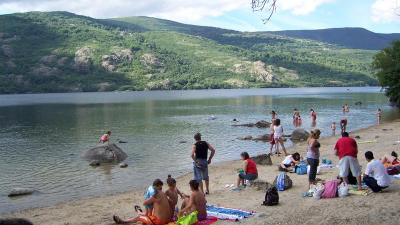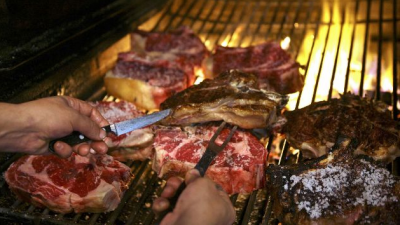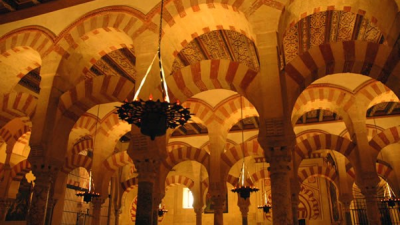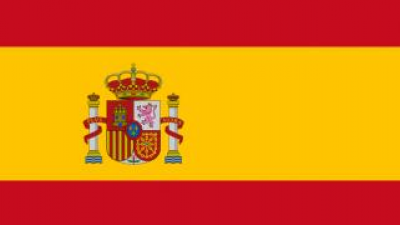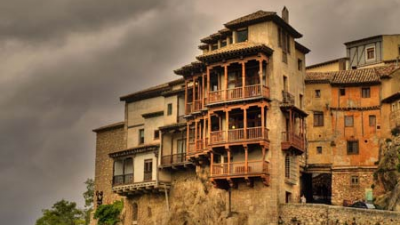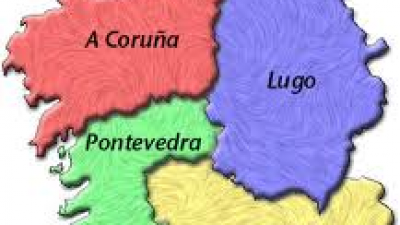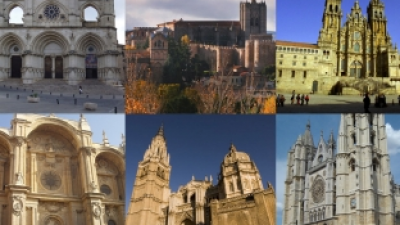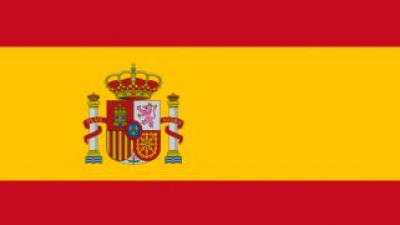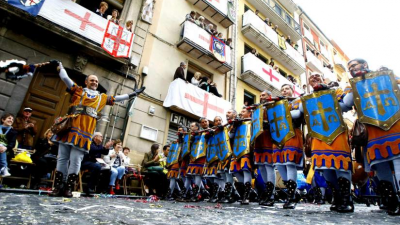Magic places in Spain
|
NEWS
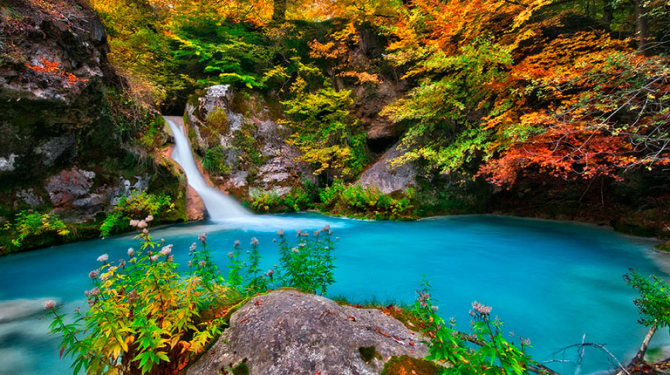
Source: listas.20minutos.es
Dream waterfalls, forests that seem out of a fairy tale, rock formations with the most curious shapes you can imagine, caves in which any dragon could doze, turquoise waters, red lands ... Spain hides corners of such spectacular beauty as unknown and that show that it is not necessary to leave the country to see incredible places.
TOP 60:
Parc del Montnegre i el Corredor (Barcelona).
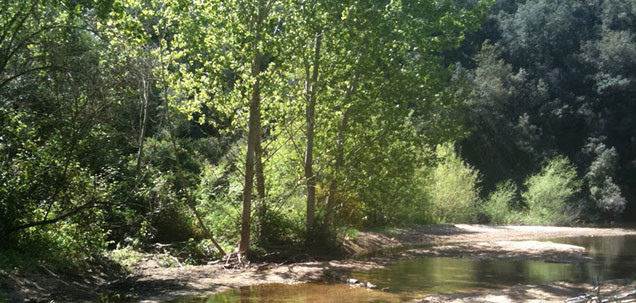
A park that stands out for its oak, oak or cork oaks that extend to the sea. A green area that hides Neolithic dolmens in places where magic flows in the forest.
TOP 59:
Orrius Forest (Barcelona)
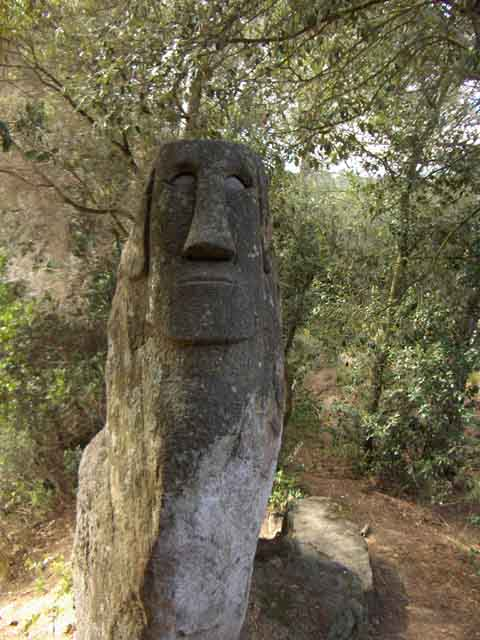
They call it the enchanted forest because there are those who have the firm conviction that there are spirits that can be seen at night. But although that act of faith is only available to a few, what is certain is that moais similar to the heads of Easter Island can be seen in its rocks, as well as giant elephants, turtles, fish and people's heads very similar to those sculpted by the Maya. There is no lack of those who relate this forest to the sighting of unidentified flying objects, just as there are convinced that what appears in its rocks are nothing other than the figures of an alleged planet inhabited in the shadow.
TOP 58:
Fageda d'en Jordà, Olot (Catalonia)
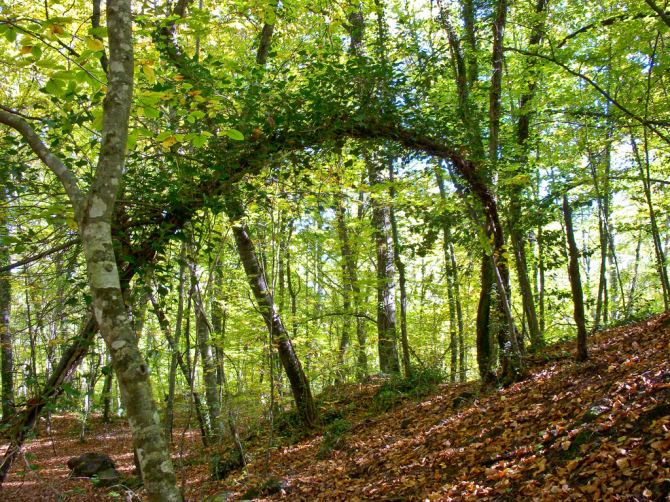
Mountains that are actually sleeping volcanoes, green landscapes until sight is lost and trees that draw patterns on the ground with their roots are some of the reasons why the Hayedo de Jordà is an incredibly magical place. In the Natural Park of the Volcanic Zone of La Garrotxa, in spring and autumn it becomes a multicolored canvas that should not be surprised to cross you with some mythological being. Take a book, food and sit and wait ... maybe you'll be lucky.
TOP 57:
Petroglyph of Mogor (Pontevedra)
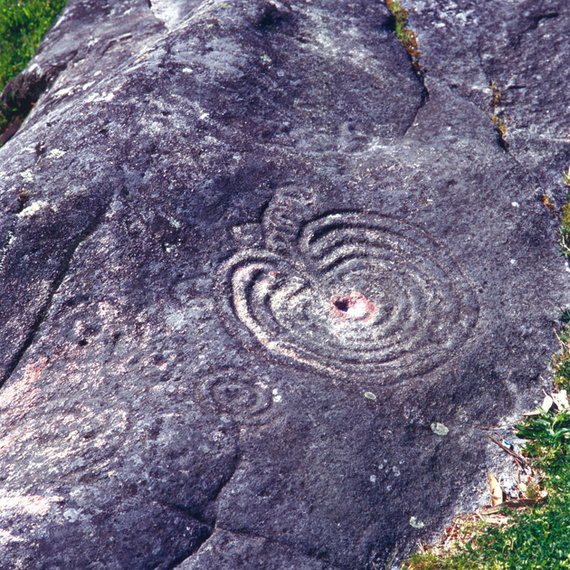
There are many drawings in stone throughout Galicia; in Campolameiro, in the same province of Pontevedra, there is one of the most important rock art ensembles in all of Europe, but the Mogor petroglyph is of greater esoteric importance because it represents a labyrinth, one of the oldest and most present symbols throughout of history Four thousand years ago these designs were drawn with a meaning still to be unraveled; A walk through the rocks from the nearby beach of Mogor invites you to discover whether it was a solar calendar, an astronomical route, a place of worship of the dead or a mere territorial mark.
TOP 56:
Axeitos dolmen (Galicia)
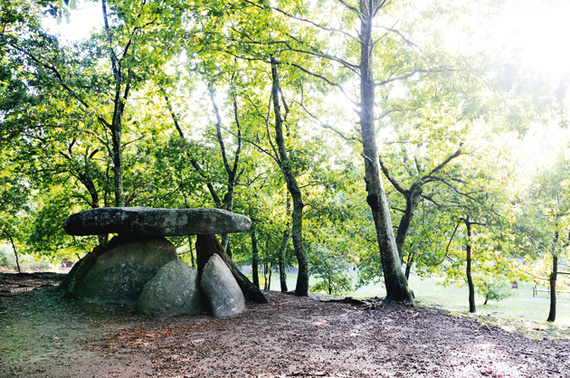
Official theory tells us that dolmens were burial places, but it is hard not to become mystics and attribute more uses, perhaps druidic, to visit it. Its reasonably good conservation, its location in a forest in one of the areas with the highest concentration of "magical" enclaves, its similarity to other stone constructions, such as menhirs and crómlechs of all Europe, and its antiquity, around 4000 before Christ, makes this megalith of Riveira one of the most emblematic places of Galicia.
TOP 55:
Xunco River, Cervo (Galicia)
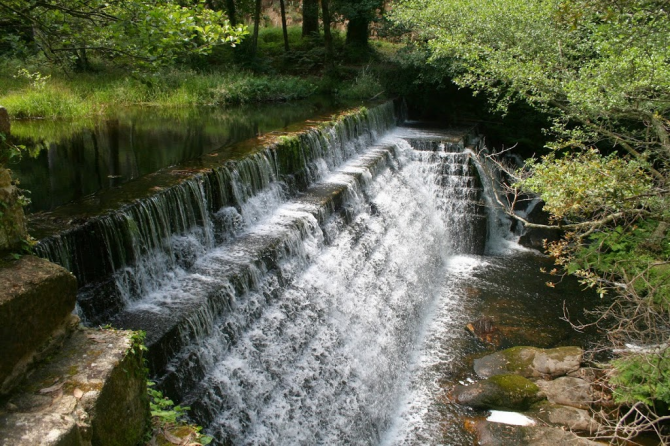
It flows into the beach of Rueta and goes from the interior to the coast. The Xunco River crosses places of great beauty and throughout its course, enabled as a path between Sargadelos and Cervo, nature and history are emerging: it was a driving force of mills, gave impetus to the manufacturing complex created by Antonio Raimundo Ibáñez and in its surroundings are places as evocative as the Paseo de los Enamorados. The route can be made starting from the coast as well as from the historical site.
TOP 54:
Birch Río Frío (Ciudad Real).
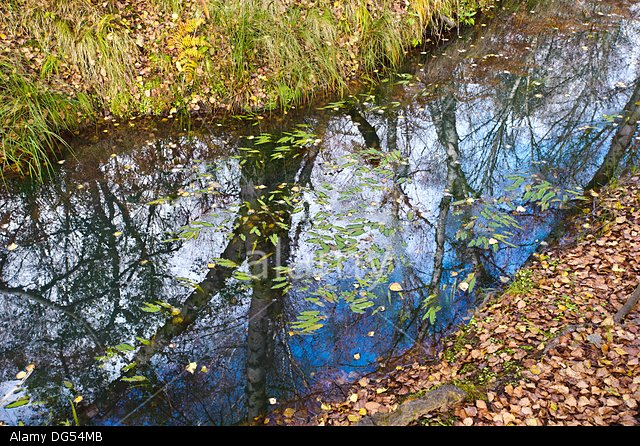
This beautiful birch grove is an almost unique place in the Iberian Peninsula, a haven of peace
TOP 53:
Ochate (Burgos)
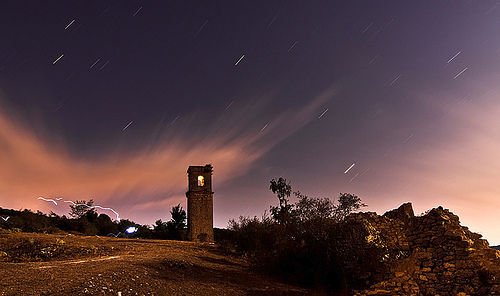
This town in Treviño County, uninhabited for decades, became a place of pilgrimage as early as the 1980s, when Mundo Unconocido published an article about a photograph of an alleged UFO flying near Ochate. It was then that rumors began to spread about mysterious epidemics that had ended up uninhabiting the town, as well as strange phenomena related to disappearances and even spontaneous combustion. Although none of that has been proven, the truth is that Ochate is still being talked about as one of the most mysterious villages in Spain.
TOP 52:
Roque Nublo (Gran Canaria)
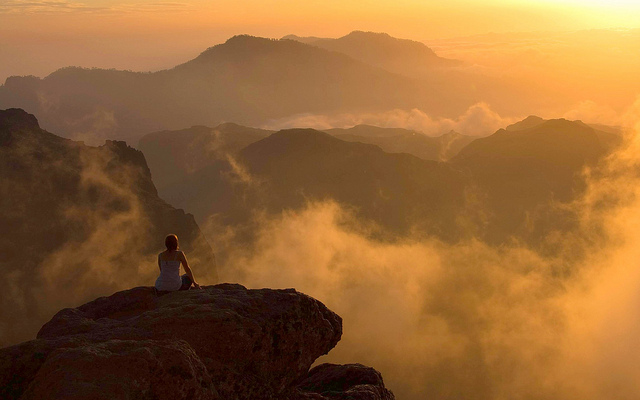
In Roque Nublo, you can see one of the best sunsets in Spain. Roque Nublo is a rocky promontory about 1,500 meters above sea level on the island of Gran Canaria where at sunset, especially in spring and summer, trade winds contribute to form a sea of clouds, a unique opportunity to see a cloud blanket from above, impregnated with the orange color of sunlight.
TOP 51:
Belmonte Castle (Cuenca)

It is a restored castle and turned into a museum and event venue, which allows us to visit it in depth, appreciating its Renaissance origin and the 19th century reforms commissioned by Eugenia de Montijo, Empress of France. The outer enclosure of the castle, walled and pentagonal, joins the walls that descend to Belmonte. At the entrance door we find a gothic cover. The fortress within that enclosure is formed by three bodies forming a triangle, composed of the tribute tower, and six circular towers reinforcing them. Inside, rooms, galleries, the chapel, and several arches are preserved. Some of these elements are original, and others are part of the reforms of the nineteenth century, in neo-Gothic style. On a medieval fortress, the construction of the current one began in 1465, since then belonging to the same family. One of its owners, Eugenia de Montijo, became Empress of France when she married Napoleon III. The Countess commissioned a series of reforms that have left a French air in the castle.
TOP 50:
The pillars of Los Órganos (La Gomera)
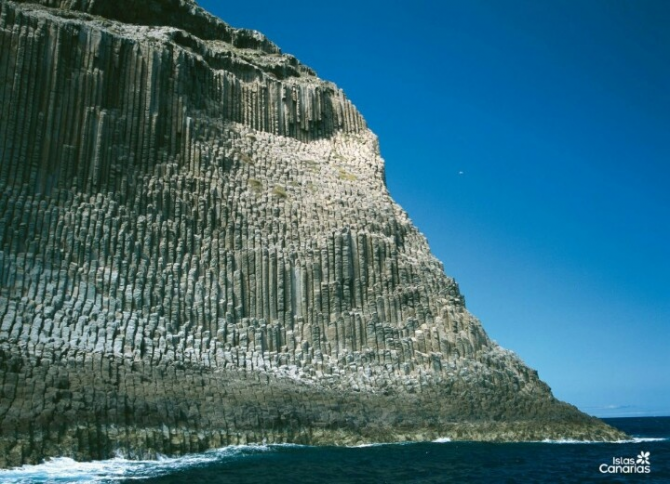
On the island of La Gomera, in the Canary Islands we are one of the places where to see the spectacle of basaltic formations, it is known as Los Órganos. They are located to the northwest of the island and the work of erosion of the sea has allowed to expose the spectacle of being able to contemplate the work of the volcanic materials when cooling. The wall was originally part of a volcano that erupted, the lava was rising but increasingly difficult because it became more dense and viscous, cooling and expanding to offer the final structure.
TOP 49:
National Park of Aigüestortes (Catalonia)
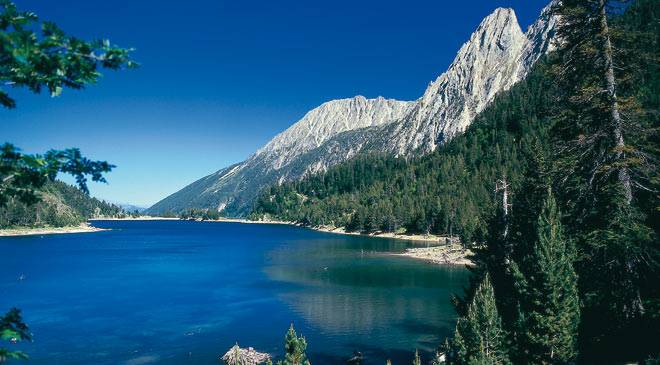
It is located in the central part of the Pyrenees divided between four Pyrenean regions: the Alta Ribagorza, the Pallars Sobirà, the Pallars Jussà and the Aran Valley, in the province of Lleida, covering, in its central part, territory of the municipal terms from Espot and Bohí Valley. It has two areas: the eastern one, with a continental climate and irrigated by the tributaries of the Noguera Pallaresa, which feed the lake of San Mauricio, and the western one (Aiguas Tortas), with a high mountain Atlantic climate and bathed by the tributaries of the Noguera Ribagorzana.
TOP 48:
Crystal Beach (Asturias)
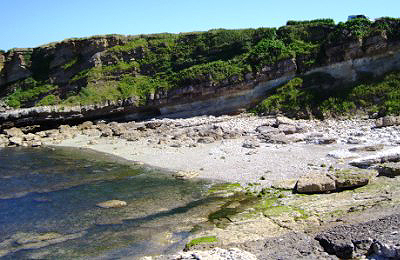
In Antromero, south of Luanco, is this spectacular beach. Although only 70 meters long, the polished crystals, coming from an old bottle dump, make it one of the most special in Spain.
TOP 47:
The Guadix Caves (Andalusia)
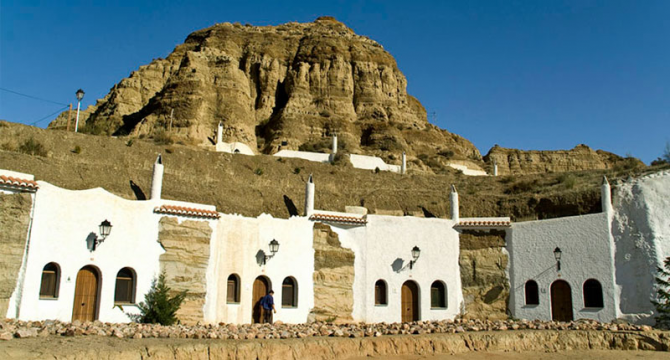
There is a neighborhood formed by troglodyte caves, pierced in the clay mountains on which it sits. Many of them have been inhabited since time immemorial and, currently, many are being rehabilitated and are even becoming accommodation for tourists such as "apartacuevas". The Guadix caves are a creation after the Arab-Muslim era; its origins must be sought immediately after the Taking of Granada, in 1492, by the Catholic Monarchs. The excavations in the hills were practiced by master alarifes, and the technique consisted of the "chopping" of the hill so that it did not collapse.
TOP 46:
Setenil de las Bodegas (Cádiz)
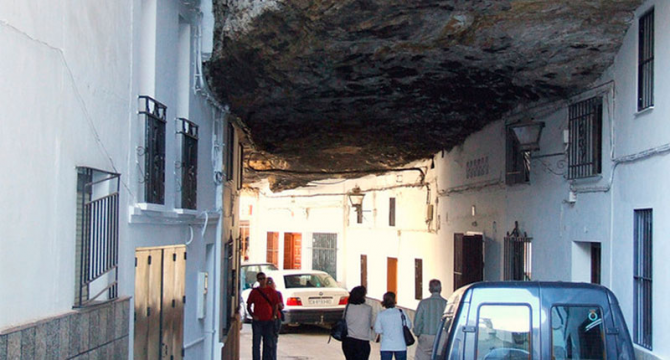
This beautiful and strange town located in Cadiz, has a great particularity, all its beautiful white houses are built under an outgoing and imposing rock.
TOP 45:
Puddle of the Clicos, El Golfo (Lanzarote)
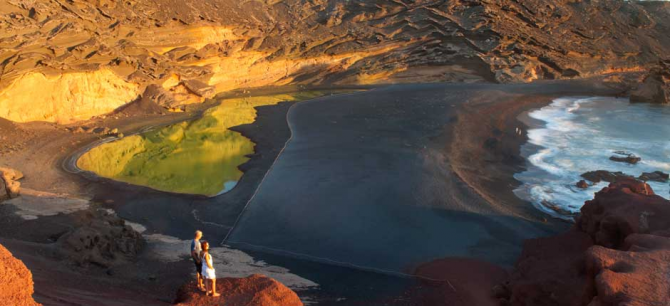
On the west coast of Lanzarote, near Yaiza, you can find a landscape of contrasts. In it, the crater of an ancient volcano plunges into the Atlantic Ocean creating a lake known as the Charco de los Clicos, declared a Nature Reserve. Its green color, caused by the algae found in the background, contrasts with the black sand of the so-called El Golfo beach, located just 100 meters from the lake, and with the blue of the sky and the sea. A volcanic landscape by the sea to enjoy To better appreciate the views, it is best to visit the viewpoint of El Golfo first, especially during the last hours of the day, in which calm and silence reign in the environment. A path that descends from the parking lot and the viewpoint to the beach allows you to enjoy in first person the peculiar volcanic landscape of the Charco de los Clicos and the sunset along the seashore.
TOP 44:
Jesters of Pría (Asturias)
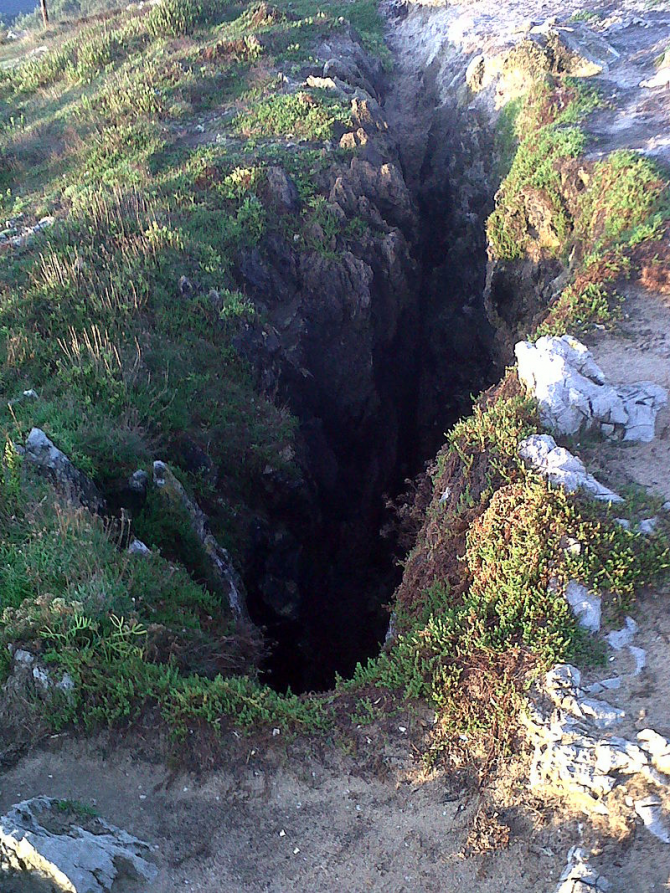
The jesters of Pría are in the Spanish town of Llames de Pría, in the Asturian council of Llanes. It is the most western group of jesters of the Asturian coast. It is integrated into the Protected Landscape of the Eastern Coast of Asturias. A jester is a karst formation that consists of a vertical hole formed a few meters from the edge of a limestone cliff that communicates with the sea. When the tide rises and the waves beat hard, it expels a stream of pulverized seawater upwards, which causes a characteristic sound that is what gives it the name of jester. The water spray can reach more than 10 meters high and the snort can be heard several kilometers away.
TOP 43:
Montserrat Mountain (Barcelona)
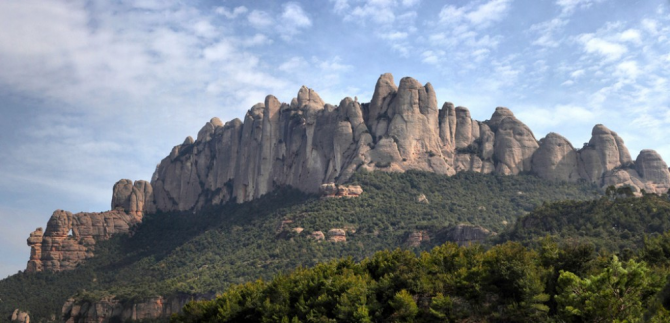
A legend that began in 880 says that that year some shepherds saw a strong light coming down from the sky several times accompanied by a soft melody, until the Bishop of Manresa organized an expedition in which they discovered a cave. Inside they found the image of the virgin. But in addition, Montserrat has been linked to witchcraft, paranormal events and even the Holy Grail: they say that the head of the SS, Heinrich Himmler, made an enigmatic visit to this place in 1940. The aim was to find the famous Holy Grail , since his tracks led him to Montserrat. However, neither of the two abbots of the monastery wanted to receive it.
TOP 42:
La Geria Lanzarote Canary Islands.
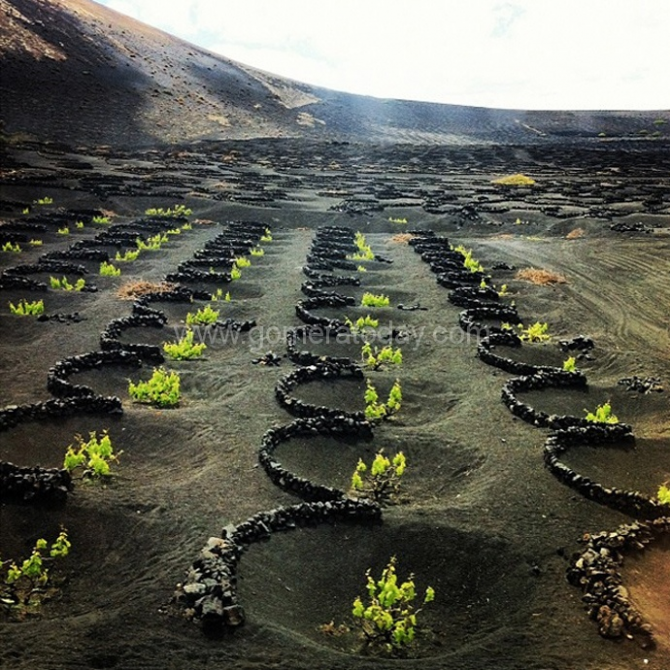
How can the dry island of Lanzarote produce its excellent white and sweet wines? The answer is the 'geria', a conical hole dug in natural layers of volcanic gravel several meters deep, in the center of which a vine is planted, and on whose edge a crescent of rocks is placed as protection against the wind . Row after row of these perfect hollows dyed green, ocher and black produce a unique landscape in the world, which helped justify the declaration of Lanzarote as a Biosphere Reserve by Unesco.
TOP 41:
Tabernas Desert (Almería)
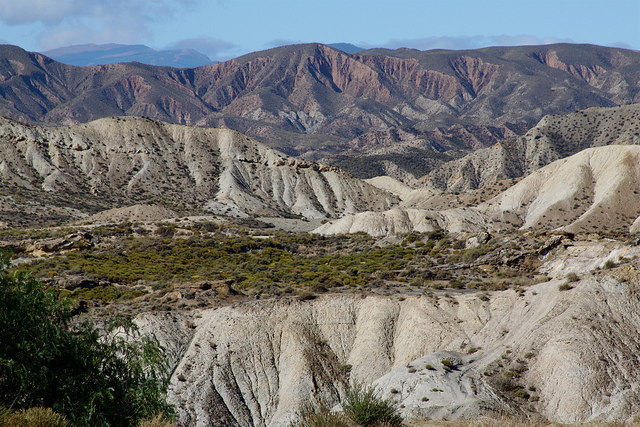
It is called the Tabernas desert, in the province of Almería. It is a protected park and the only desert considered as such in the entire Iberian Peninsula. Although rains can happen, the sandstone soil does not retain moisture, so it is eroded as a landscape of badlands.
TOP 40:
National Park of the Tables of Daimiel (Ciudad Real)
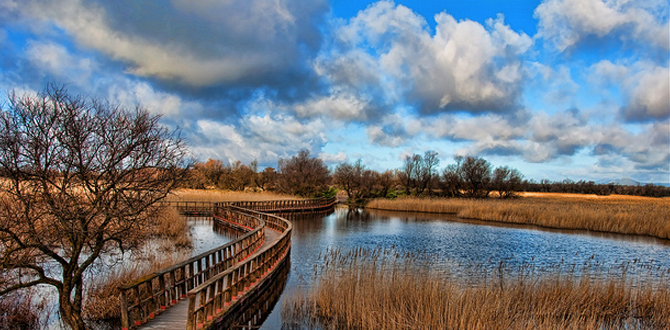
The Tables of Daimiel are a practically unique wetland in Europe and last representative of the ecosystem called river tables, once characteristic of the central plain of our Peninsula. It is a complex ecosystem that mixes the characteristics of a flood plain, produced by the overflows of the Guadiana and Gigüela rivers at its confluence, with that of a groundwater discharge area from a large aquifer. These overflows, favored by the lack of slope on the ground, have matched the development of a powerful and characteristic vegetation cover that constitutes an exceptional habitat for all fauna linked to the aquatic environment. With the declaration of the National Park, a great step was taken in the conservation of one of the most valuable ecosystems in La Mancha, thus ensuring the survival of the birdlife that uses these areas as a wintering, spotting and nesting area, creating an Integral Zone of water birds.
TOP 39:
Mouth of the Xallas (Ézaro, La Coruña)
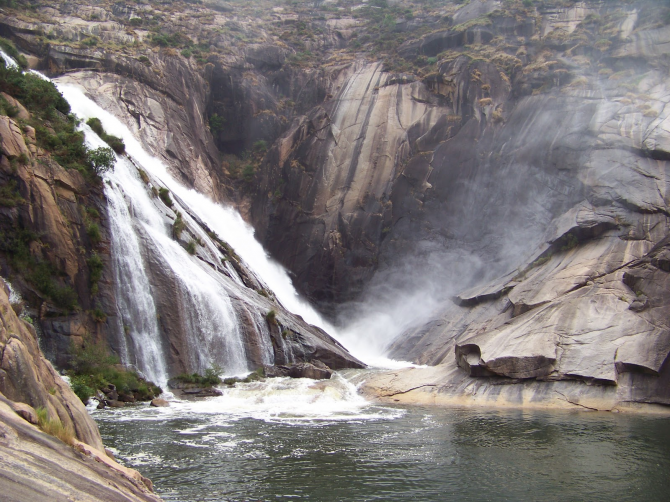
The Xallas river flows into the Ézaro. in an impressive waterfall of about 100 meters, it is the only river in Europe that flows into a waterfall, it is a sight worth seeing. The well, formed by the force of water, has a depth of 20 meters.
TOP 38:
Sa Calobra (Mallorca)
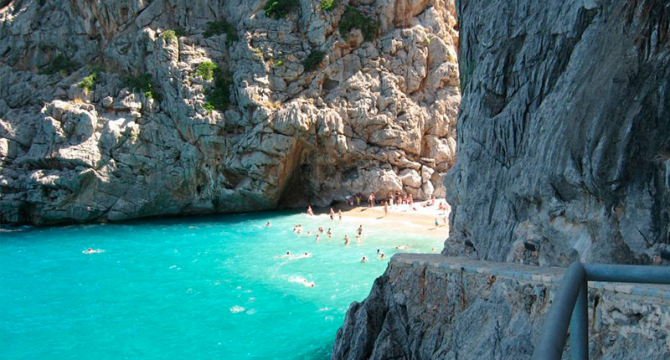
They were thousands of years of erosion of the Torrent de Pareis watercourse, which crossing the Sierra de Tramontana meets the sea in a corner of the coast of the island of Mallorca. But he does it in a special way. In its last section, the Torrent de Pareis crosses a bed of boulders until it flows into an intense and transparent blue sea, all between cliffs that reach 200 meters of fall. It is called Cala de Sa Calobra, a narrow space, just 25 meters from pebble beach between the cliffs.
TOP 37:
National Park of La Caldera de Taburiente (La Palma)
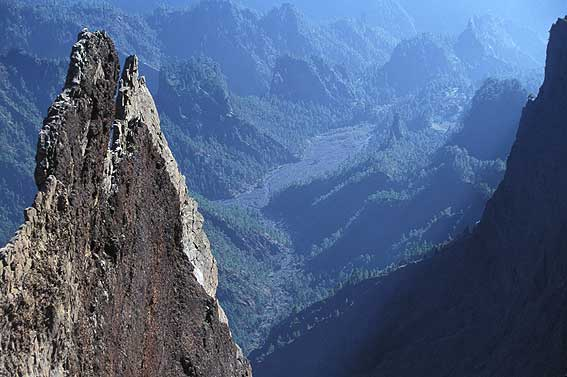
Like all boilers and in shield volcanoes, its origin is in the existence of a relatively large crater with lava that, when cooled, produces basaltic rocks.
TOP 36:
The Hayedo de Montejo de la Sierra (Madrid).
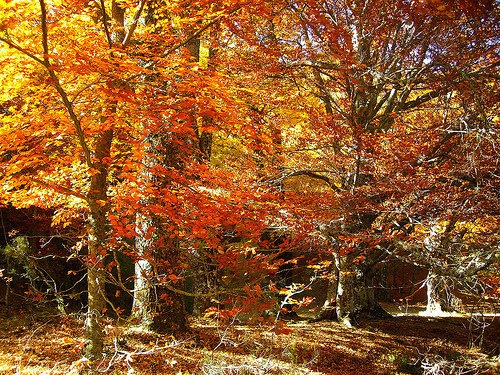
A forest that keeps a beautiful legend. The elves and fairies that inhabit it attract the walkers with their sweet song to turn them into beautiful animals and thus increase the beauty of this incredible forest.
TOP 35:
Natural Park of Fragas do Eume (A Coruña)
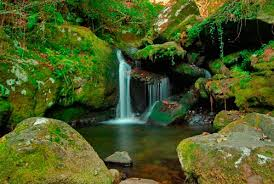
A natural park that we can walk on foot thanks to its network of trails. The roads will take us to the riverbank, between mosses and ferns.
TOP 34:
Mines of Riotinto (Huelva)
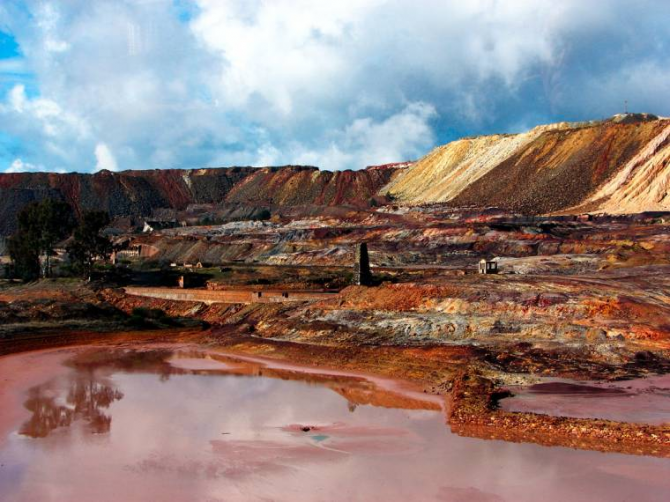
Here 70 sculptures from a settlement that they named as Treasure Plain appeared almost 40 years ago. The curious thing about that discovery is that those 70 heads carved in stone discolored the entire anthropological guild. The reason is that the sculptures, sculpted in prehistory, represented men of different human races. However, at that time there was still no contact between the different races, which would mean that the ancient inhabitants of Rio Tinto could rewrite our history. An enigma that, for now, remains unsolved.
TOP 33:
Caves of Drach (Mallorca)
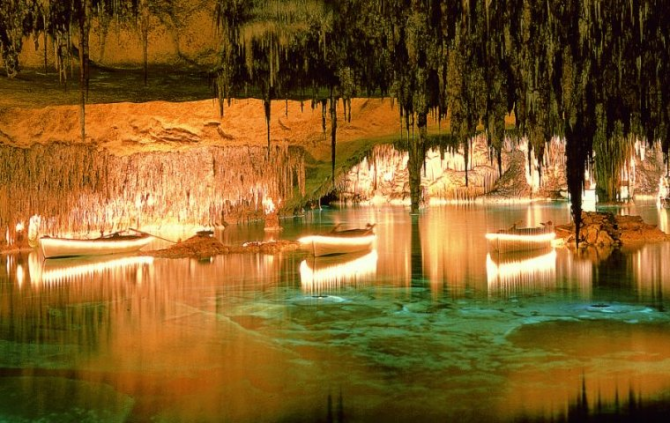
Watching the Drac Caves of Mallorca it is easy to imagine a sleeping dragon surrounded by treasures while the dim light illuminates and the raindrops slide down the stalactites to an inland lake. This magical corner is four large caves near Manacor that are more than 2.4 km long and reach 25 meters underground. Inside, a large underground lake is hidden next to which you can hear classical music live ... More beautiful impossible.
TOP 32:
Garajonay National Park (La Gomera)
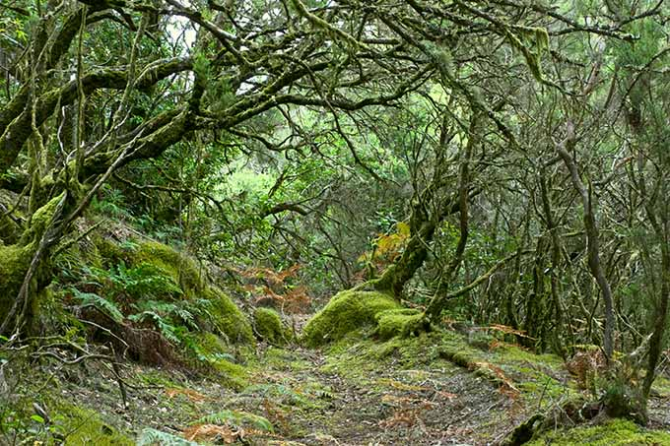
A curious leafy forest that emerges on the volcanic island of La Gomera. The legend of Gara and Jonay is the love story of an aboriginal prince and princess who, due to the opposition of their families, decide to commit suicide. The version of Romeo and Julieta canaria.
TOP 31:
Hoces del Duratón, Segovia.
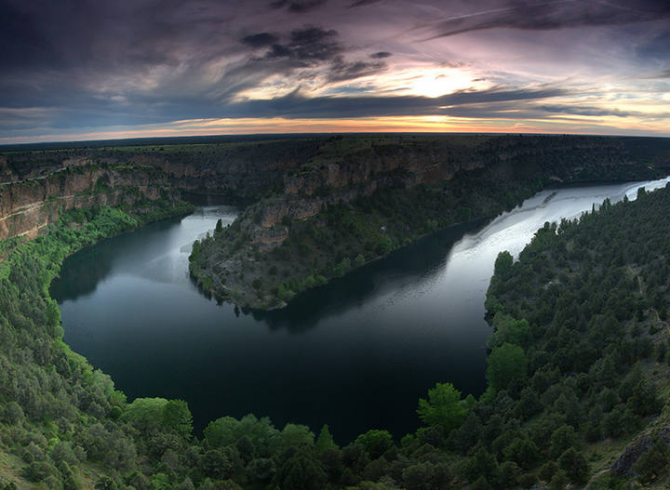
The Hoces del Río Duratón Natural Park is a protected area that includes the environment of the sickles that this river has in its middle section. These are the canyon that Duraton, a tributary of the Duero River, has excavated in an area of limestone between the towns of Sepúlveda and Burgomillodo (annex of Carrascal del Río), northeast of the province of Segovia (Castilla y León, Spain) .
TOP 30:
Pedraza (Segovia)
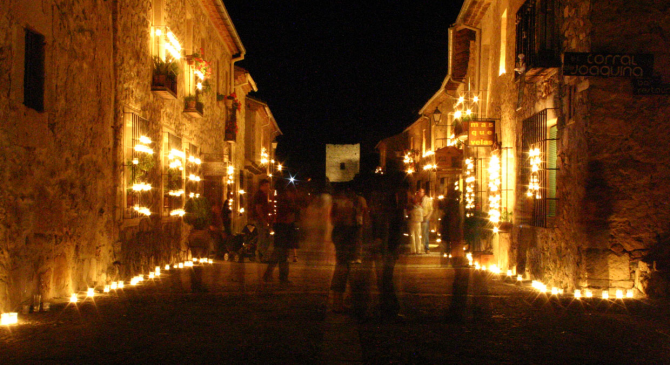
It is a walled medieval village, whose careful rehabilitation motivated its declaration as a Historic Site in 1951.
TOP 29:
Torcal de Antequera (Málaga)
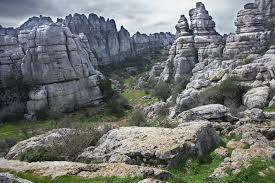
Due to the rarity and magnificence of its strange formations, the Torcal de Antequera offers an impressive landscape considered unique in the world, a fact that motivated its declaration in 1929 as a Site of National Interest. Its 1,171 hectares have served countless science fiction films on a number of occasions, since in its labyrinthine structure of torcas, corridors, caves and chasms (such as Toro and Marinaleda), breaks and gorges, whose best exponent is the El Torcal Screw , it is easy for the walker to get lost. The limestone aspect of the composition of its terrain makes it easily sensitive to erosion by weather agents, such as rain or wind.
TOP 28:
Lagoons of Ruidera (Tomelloso)
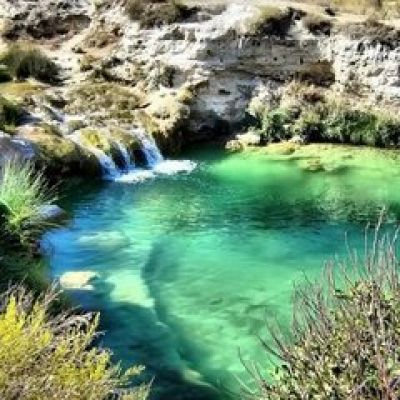
Las Lagunas de Ruidera, is a place of great beauty with landscape and geological singularities, located in Castilla La Mancha, in the limits of the provinces of Ciudad Real and Albacete. This natural park is formed by a complex lagoon system formed by fifteen lagoons, which along 30 kilometers constitute the Alto Guadiana valley and in its highest part the birthplace of the Guadiana river. Ruidera is one of the most amazing natural places in Spain, a place of great landscape value, with a variety of environments to discover and explore knowing its lagoons, enjoy immense lagoons, transparent waters and intense turquoise blue. The fifteen lagoons overflow and flood each other forming waterfalls and jumps due to geological formations such as travertine barriers. Which are the most characteristic feature of this natural park. Ruidera is home to an amazing biological richness with a great diversity of animal and plant species, holm oak and sabinar forests, sotos, poplar groves, and marshy vegetation such as Masiega or Enea. A note of freshness and almost unreality in the flat and dry spot.
TOP 27:
Natural Park of the Sierra de Cazorla, Segura and Las Villas (Jaén)
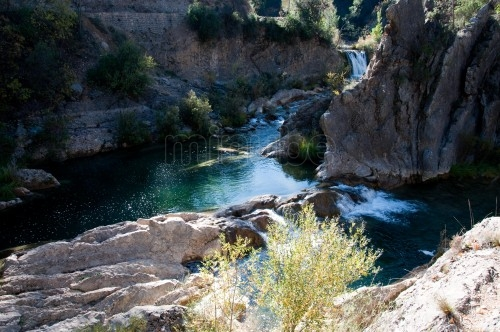
The Sierras de Cazorla, Segura and Las Villas Natural Park impresses the visitor with its rugged mid-mountain relief. High-rise rocky walls intermingle with deep valleys and leafy forests of lark pine trees. Among its peaks are the Empanadas and Cabañas with more than 2,000 meters of altitude, the Yelmo being one of the most frequented for the practice of free flight. Water is another of the main elements of this natural space, the largest protected area in Spain with its 209,920 hectares. The extensive existing hydrographic network allows not only to enjoy a great variety of flora and fauna, but also to carry out numerous activities: a boat trip on the Tranco reservoir, hiking along the Borosa river or knowing the births of the Guadalquivir and the Segura or the Waterfall of Jet Gil are just some of the possibilities.
TOP 26:
The Enchanted City (Cuenca)
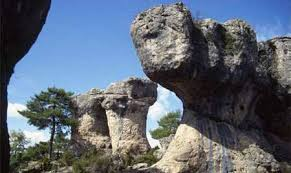
The Júcar River, as it passes between Uña and Villalba de la Sierra, forms a gigantic and impressive canyon. It is here, at almost 1,500 m. altitude, where nature has allowed one of those whims that always fill the traveler with amazement: The Enchanted City, declared a Natural Site of National Interest. These geological phenomena, known worldwide, are rock formations literally sculpted by the action of water, wind and ice, which by eroding the rocks for centuries, has managed to model human figures, objects, animals, with an accuracy difficult to understand, even get a delusional city, a city that seems asleep from some mysterious spell.
TOP 25:
Cave of the Greens (Lanzarote)
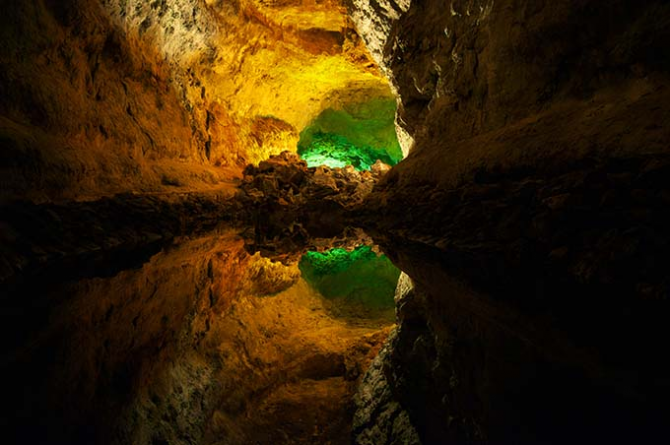
On an island as volcanic and unique as Lanzarote it is not surprising that there is a place like the Cueva de los Verdes. This volcanic tube was formed 5,000 years ago and goes from the Corona volcano to the coast along more than 7 kilometers. It is one of the longest lava tunnels in the world and for centuries it was a refuge for the local population. Today you can visit and it is unforgettable.
TOP 24:
Costa da Morte (Galicia)
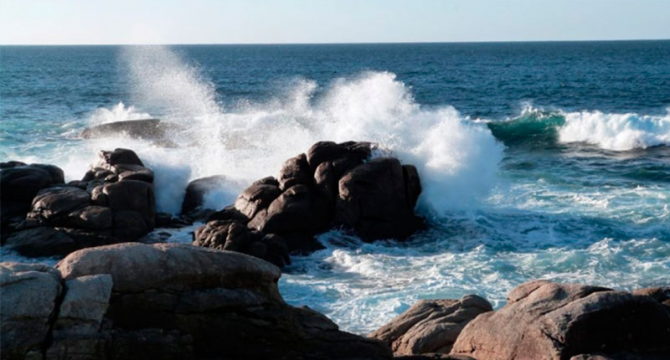
Its name comes from the Viking ships that sowed panic on this coast and the more than 60 shipwrecks that occurred in less than 100 years, including the sinking of HMS Serpent, the tragedy in which 172 English sailors died. The Costa da Morte runs through Galicia from the Cabo de San Adrián to the Finisterre Lighthouse. This wonderful place becomes, with its green cliffs, one of the most magical in Spain.
TOP 23:
Timanfaya National Park (Lanzarote)
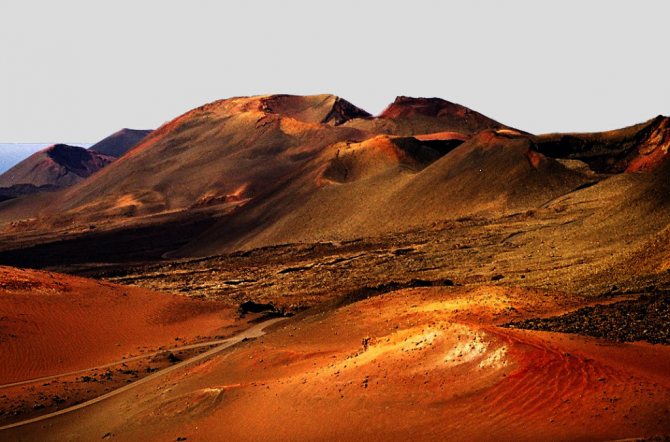
Officially known as the Timanfaya National Park, this spectacular place is located in Lanzarote, along 51 square kilometers. Timanfaya Park has more than 25 volcanoes, among which the Mountains of Fire or the Caldera del Corazoncillo stand out.
TOP 22:
Gorge of Hell (Extremadura)
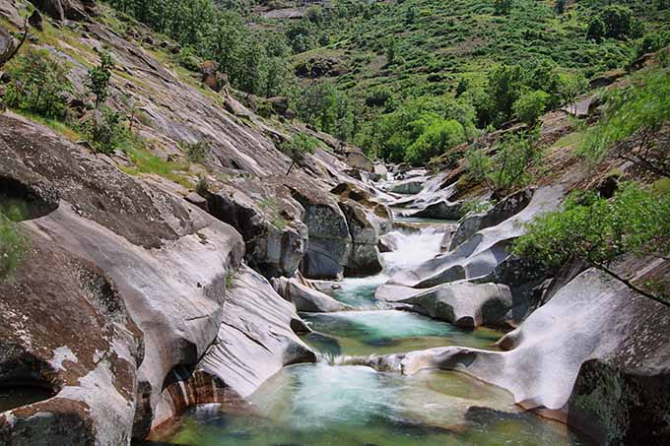
The Garganta de los Infiernos Reserve is, without hesitation, a second, one of the most unique landscapes hidden in Spain. Located in a privileged place north of the province of Cáceres, at the western end of the Sierra de Gredos and in the heart of the Jerte Valley it is a place full of waterfalls, streams, waterfalls and, especially, swimming pools Natural and large circular pools (the famous "pylons") carved into the rock by the erosion of river water. Perfect for a hiking trail and also to cool off when the heat squeezes. You will feel like a place worthy of "The Lord of the Rings" or "The Hobbi
TOP 21:
Albarracín (Aragon)
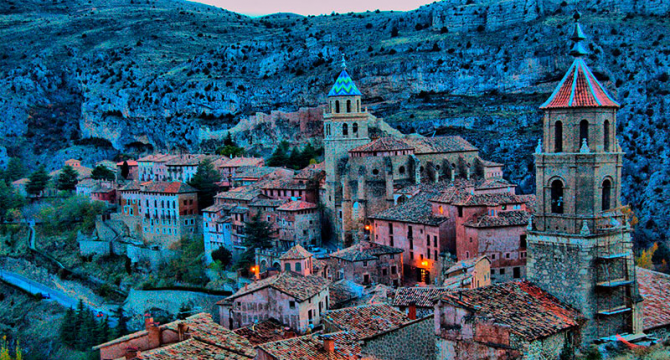
With a spectacular historic center, Albarracín awaits us at 1182 meters. Declared a Historic-Artistic Site since 1961, you will transport yourself in time without any effort and if you come in winter, the snow and cold will make you feel even more authentic. It is currently proposed by UNESCO to be declared a World Heritage Site.
TOP 20:
Bárdenas Reales (Navarra)
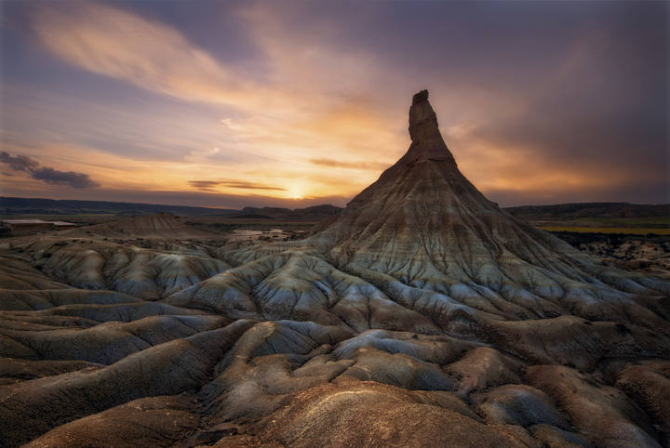
It is a Natural Park of wild beauty declared a Biosphere Reserve by UNESCO. A semi-desert landscape of 42,500 hectares that impacts and surprises with each new visit. An unusual show southeast of Navarra, close to Tudela, which despite its naked and inhospitable appearance, hides great natural values. In Bardenas Reales, the erosion of its clays, gypsum and sandstone soils has sculpted capricious forms creating a world of almost lunar appearance populated by ravines, flat plateaus and lonely hills. Source of inspiration for painters and writers and stage of television commercials, music videos and films such as "Airbag", "Mutant Action", "Pride and Passion" or "The world is never enough".
TOP 19:
Ronda (Málaga)
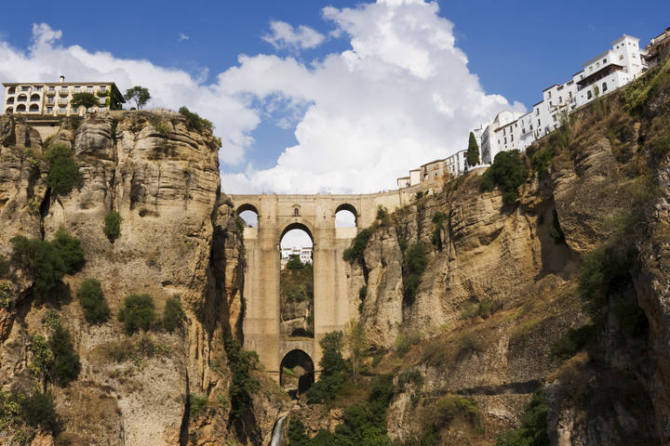
The spectacular views from the abyss of Ronda make this city of Malaga one of the most magical places in Spain. Ronda, one of the oldest cities in Spain, is located on a plateau 750 meters above sea level, on the edge of the cliff that ends at the Guadalevín River.
TOP 18:
Gulpiyuri Beach (Asturias)
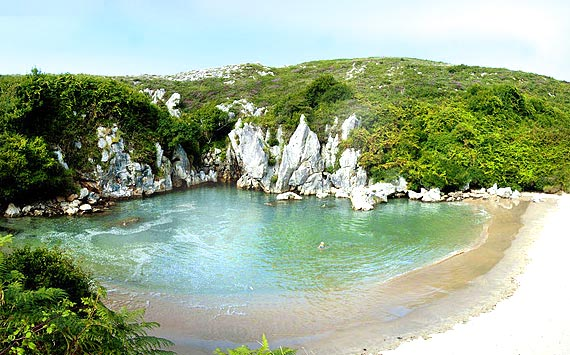
Gulpiyuri beach is a small beach located in the municipality of Llanes, north of the town of Naves, halfway between the towns of Ribadesella and Llanes. It can only be accessed by walking from the beach of San Antolín or from Naves and its isolation has allowed the relatively good conservation of this small and delicate natural jewel. The depth and size of the water zone only allows you to soak lying down, but it is well protected from the wind. It is a small sea beach but located inland, among green agricultural meadows. On a cliff coast of limestone rock the sea was creating a cave inland and the bottom of the cave sank, (a karst phenomenon known as dolina), leaving a small circular hole about 50 m in diameter at 100 m from the coast. This sinking is still connected to the coast and the sea water enters, also showing the tides and having a beach of fine sand.
TOP 17:
Roman theater of Mérida
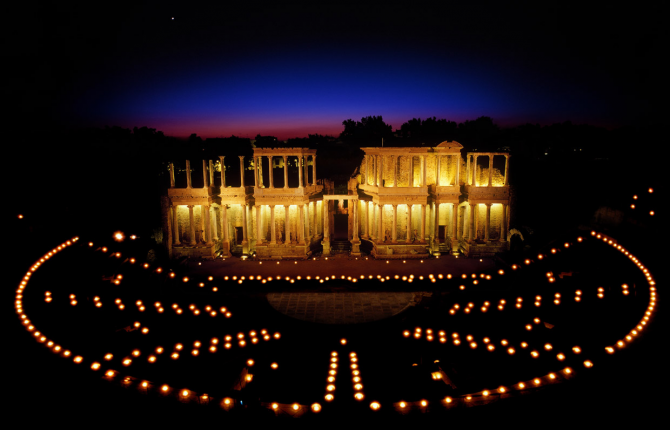
The Roman Theater of Merida is a historical theater built by Ancient Rome in the Augusta Emerita neighborhood, now Merida. Its creation was promoted by the consul Marco Vipsanio Agripa and, according to a date inscribed in the theater itself, its inauguration occurred around the years 16-15 a. C.
TOP 16:
The Walls of Ávila
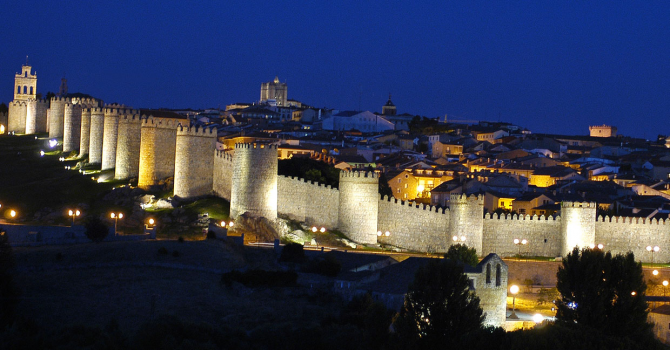
The Wall of Avila is a Romanesque military fence that surrounds the old town of the city of Avila. Currently, the old town, the wall and the churches located outside the walls have been declared a World Heritage Site. The walls are the universal symbol and most prominent monument that houses the city of Avila. Its importance derives from being the best preserved medieval walled enclosure in Spain and probably throughout Europe. The walls are a very important active factor in shaping the urban planning of the city and have historically participated in the distribution of urban space among the various social groups that have inhabited Ávila. The wall represented the separation between "wild space" and "civilized." The countryside, the flat land, lived the peasants who were the lowest social class that maintained the city. 80% of urban infrastructure costs fell on the peasantry, including the wall whose maintenance is called the repair of the walls. According to tradition, the direction of the construction of the wall fell on the two masters of geometry, the Roman Casandro and the French Florín de Pituenga. The study of the defensive structure indicates that it is a related construction, in its morphology and multi-aesthetics (art of building walls and castles) to the walls of the Andalusian area
TOP 15:
Mosque and Roman Bridge of Cordoba
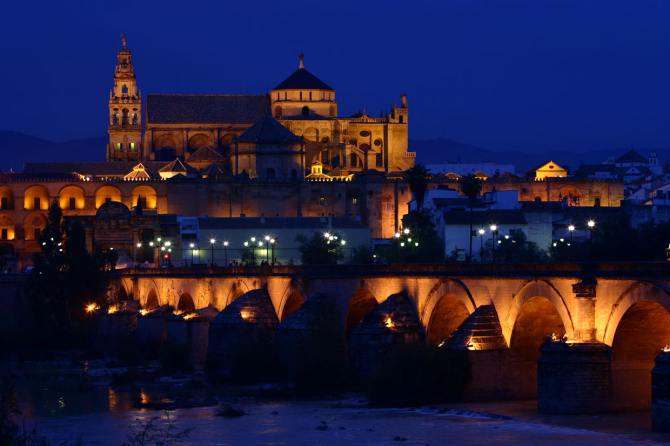
The Roman Bridge of Córdoba is located on the Guadalquivir River as it passes through Córdoba, and connects the Campo de la Verdad neighborhood with the Cathedral District. It was built in the early 1st century AD, probably replacing a more primitive one of wood, it has a length of about 331 meters. It was one of the most important means of entry to the city from the southern part of the Iberian Peninsula because it is the only point to cross the river without using any type of boat. Probably the Via Augusta that went from Rome to Cádiz passed through it. The current Puerta del Puente was made by the architect Hernán Ruiz II in 1572. In the center of the bridge is a triumph of the San Rafael, dating from 1651, the work of the sculptor Bernabé Gómez del Río. In front of this figure we can find a niche dedicated to the patrons of the city of San Acisclo and Santa Victoria. In Córdoba it is easy to hear wrongly that the patron the city is the Archangel San Rafael, but if we go to the bibliographic archives we can verify that the patrons are really the saints mentioned. The environment of the Roman Bridge presents a remarkable singularity because it is located in a small nature reserve, called the Sotos de la Albolafia. In this place many bird species nest (a total of 120 are known so far), some of them in danger of extinction, which is a surprising fact if you take into account its small area of just over 2 hectares. In its environment several mills are conserved, among which the recently refurbished Molino de San Antonio, as well as the well-known Molino de la Albolafia, which, as mentioned above, is the one that appears on the city shield. Mezquita - Catedral.-The Cathedral of the Assumption of Our Lady, formerly «Santa María Madre de Dios», is the ecclesiastical name of the Cathedral of Córdoba, or former Mosque of Córdoba. The building, declared Cultural Heritage of Humanity together with the historic center of Córdoba, began to be built in 786 in the place occupied by the Visigothic basilica of San Vicente Mártir. The mosque was subject to extensions during the Emirate of Cordoba and the Caliphate of Cordoba. In 1238, after the Reconquest, the conversion of the mosque into a Catholic cathedral was carried out with the episcopal ordination of its first bishop, Lope de Fitero. In 1523 the construction of a Plateresque-style Renaissance basilica began in the center of the Muslim building. Today it constitutes the most important monument of Córdoba, and also of all the Andalusian architecture, together with the Alhambra.
TOP 14:
Nacedero del Urederra, Urbasa Andía Natural Park (Navarra)
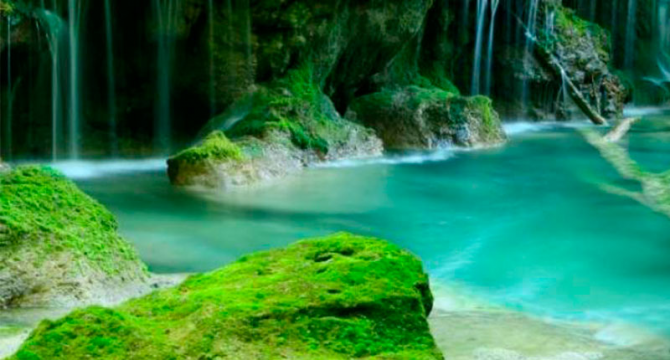
The murmur of the crystalline water, the light that seeps between the leaves of the trees staining the landscape with lime green and the aroma of nature contribute to making this place, declared a nature reserve in 1987, one of the most spectacular enclaves of Navarra. The Nacedero del Urederra, located north of Estella-Lizarra, is the natural outlet of the aquifer formed in the karst massif of Urbasa. The first emergence occurs in a cut at 700 meters of altitude on the southern edge of the massif, causing an impressive fall of more than 100 meters that over the course of millions of years has modeled a rocky amphitheater of remarkable beauty. Behind her there are other waterfalls and numerous turquoise water pools that are formed as a result of the karst phenomenon, whereby the water seeps through the cracks of the rocks emerging again and again from the bowels of the earth. The special hue of these waters is what will surely have inspired those who baptized the river with the name of Urederra, which means "beautiful water". But in addition to water, it is worth mentioning the diversity of flora and fauna that make up this natural space: beech, oak, elm, maple, yew and hazelnut trees, among other plant species, and vultures, vultures, kites, eaglets or crows, as protagonists of the animal Kingdom.
TOP 13:
Holy Cave of Covadonga (Asturias)
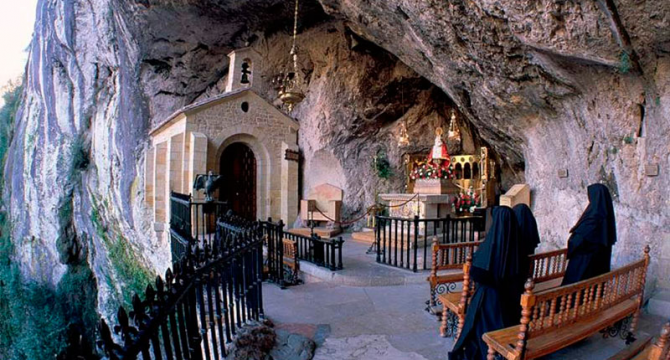
In the Holy Cave there is a small hermitage inside where the Virgin of Covadonga is located, popularly called by Asturians as La Santina. Below the cave a waterfall of the Covadonga River emerges and falls directly into a large pool. The Sanctuary of Covadonga rises near the hermitage and on top of a small hill that presides over the valley
TOP 12:
Concha Bay (San Sebastian)
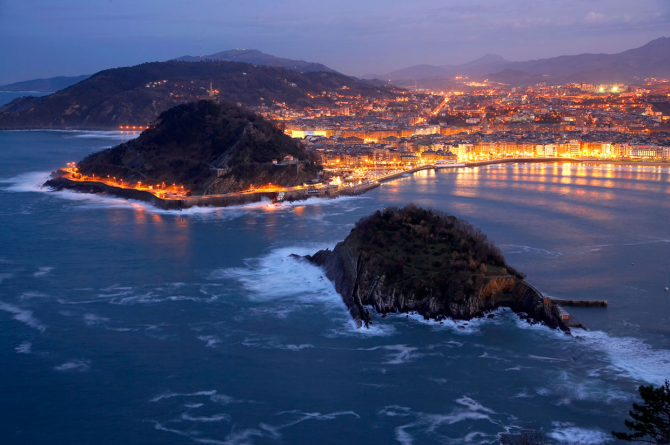
La Concha Bay is a small bay located on the Spanish coast of the Cantabrian Sea, in front of the city of San Sebastián. As the name implies, it has a shell shape, and it houses two beaches (Ondarreta and La Concha beach) and an island, the island of Santa Clara. The bay occupies the space between the mountains Igueldo (west) and Urgull (east). According to geological studies, the primitive bay covered from Mount Igueldo to Mount Ulía, which closes Zurriola beach in the east, since the current Urgull mount could have been, in all likelihood, an island. In this way, the primitive bay, with a beach line of more than 3000 meters in length, covered the three beaches of the city and two islands. Subsequently, and with the sediments accumulated at the mouth of the Urumea River, a small isthmus formed that joined the island of Urgull to the mainland, becoming a mountain. Thus the current bay was formed, whose shell shape would be consolidated with the construction of the promenade.
TOP 11:
Jungle of Irati (Navarra)
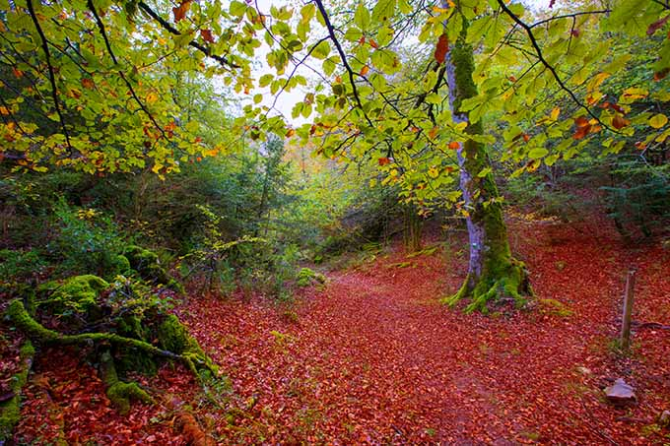
This impressive forest is the second largest beech-fir in Europe. Its numerous paths will allow us to enter the most remote corners and discover beautiful places, perhaps in one of them you can meet El Basajaun, the protector of this forest, a tall figure, long hair and prodigious strength.
TOP 10:
Stone Monastery (Zaragoza)
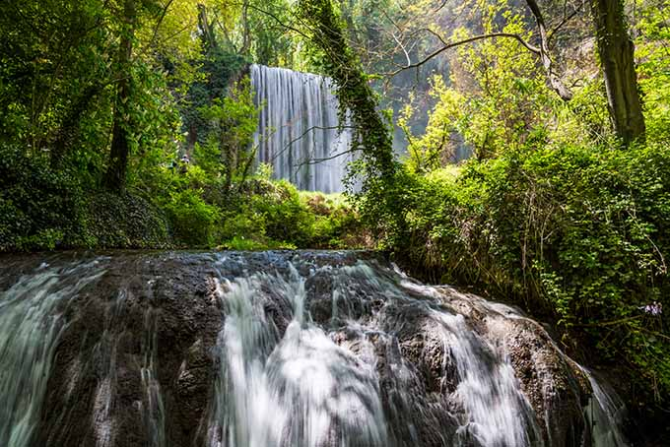
The Natural Park of the Monasterio de Piedra is a symphony of water, light and vegetation that combine perfectly to give rise to one of the most magical places in Spain. The Piedra River stream has shaped the rock in its path forming lakes, grottos and waterfalls such as the Mirror Lake or the Iris Grotto, which will leave you with your heart in a fist. Once you set foot there nothing will be the same.
TOP 9:
Gaztelugatxe (Basque Country)
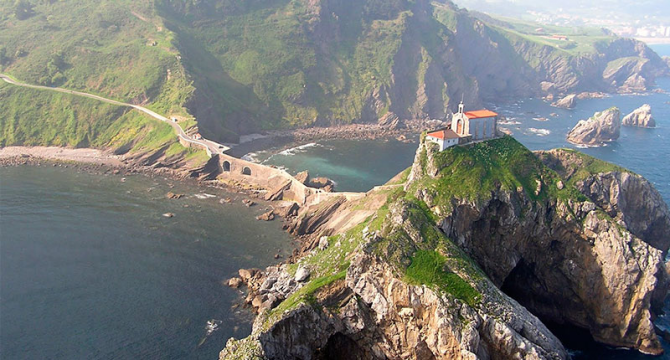
Gaztelugatxe is an islet of the Biscayan town of Bermeo. It is connected to the mainland by a bridge with two arches. On the island there is a hermitage dedicated to San Juan dating from the 10th century, although some discoveries date from the 9th century. Together with another small neighboring island, that of Aquech, it forms a protected biotope, which extends from the town of Baquio to Cape Machichaco, in the Bay of Biscay.
TOP 8:
La Albufera (Valencia)
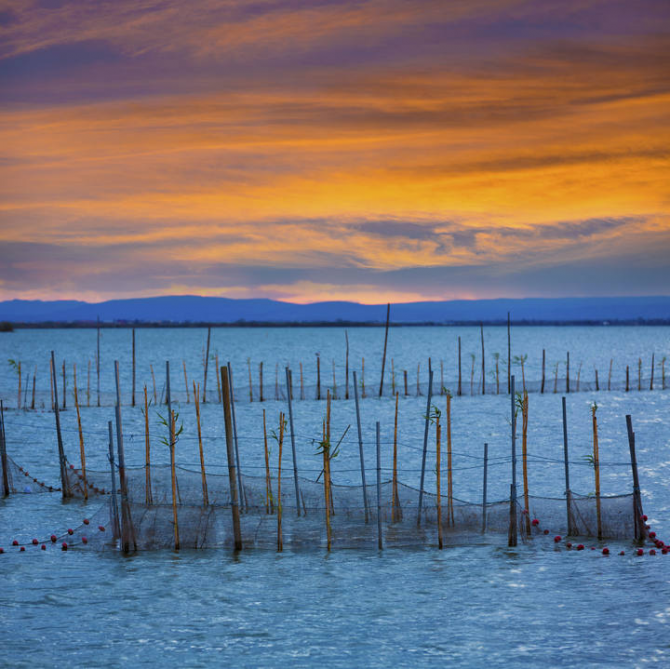
The Albufera Natural Park may be one of the best known magic spots in Spain. However, its unique fauna and spectacular landscapes make the Albufera a must-see place.
TOP 7:
Las Catedrales beach (Galicia)
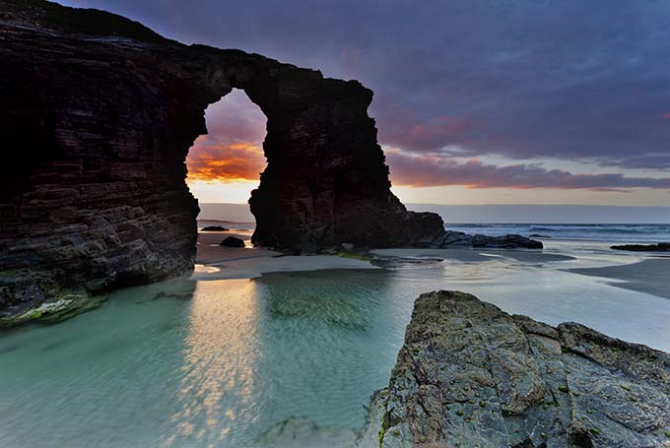
The beach of the Cathedrals is located on the coast of the province of Lugo (Galicia). It is named for the cliffs, some with more than 32 meters high, which are sculpted by the wind and the sea, form spectacular arches and vaults leaving a wonderful landscape in which it is considered one of the most spectacular beaches of the world.
TOP 6:
Las Médulas (León)
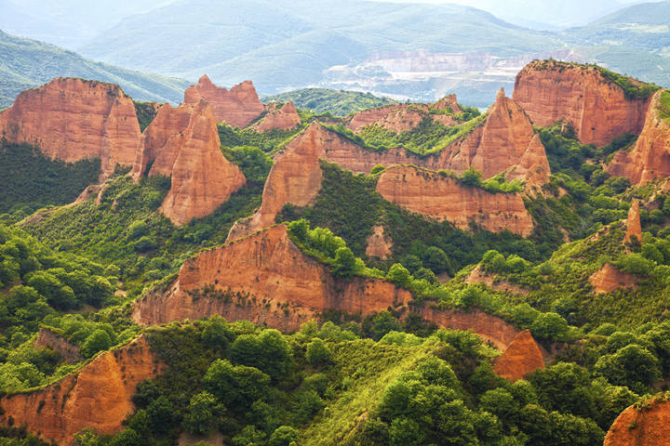
Formed by an old Roman gold mining. The engineering work carried out for the extraction of the ore involved the alteration of the environment but resulted in a landscape of reddish sands, now partially covered with chestnut and oak vegetation. It is considered a "cultural landscape" and has the denomination of "Cultural Park".
TOP 5:
Pyramids of Güímar (Tenerife)
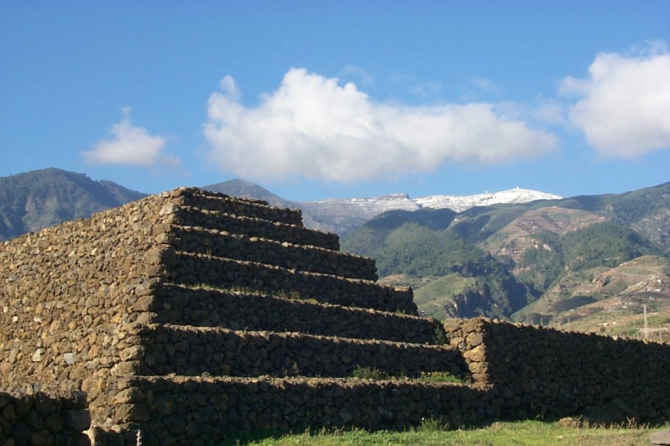
Discovered by Canarian researcher Emiliano Bethencourt, many theories have been written about them, including some that relate them to UFOs and extraterrestrial settlements. Another of these theories, which has more followers, says that they are cult buildings of the island's pre-Hispanic inhabitants, the Guanches, and considers these pyramids as the missing link between those in Egypt and the Mesoamericans. The pyramid set is oriented to the birth of the sun in the summer equinox.
TOP 4:
The Alhambra (Granada)
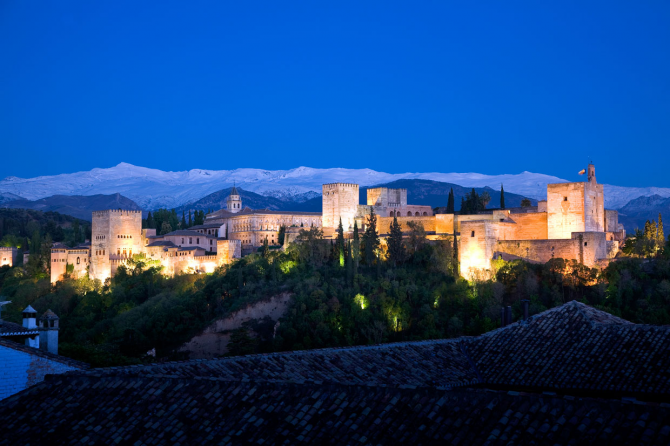
The Alhambra is an Andalusian palatine city located in Granada. Formed by a set of palaces, gardens and fortress (alcazar or al-qasr القصر) that housed a true citadel within the city of Granada itself, which served as accommodation for the monarch and the court of the Nasrid Kingdom of Granada. Its true attraction, as in other Muslim works of the time, lies not only in the interiors, whose decoration is among the summits of Andalusian art, but also in its location and adaptation, generating a new landscape but totally integrated with the pre-existing nature.
TOP 3:
Ordesa National Park (Huesca)
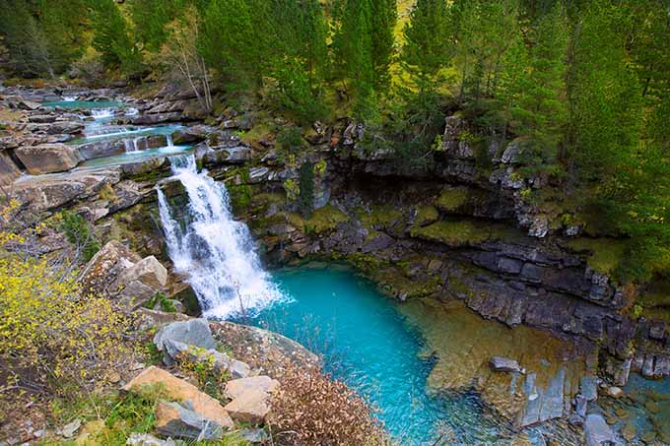
Deep valleys, high mountains, lush vegetation, rivers of turquoise waters, waterfalls that fill the environment with dew ... The Ordesa National Park seems to be taken out of a fantasy movie. This superb place stands in the Pyrenees and is a feast for the senses. With more than 15,000 hectares and the highest waterfall in Europe, choosing only one of its corners is almost impossible. Even so, we are left with the route through the Añisclo Canyon, the Pineta Valley and the famous horsetail waterfall.
TOP 2:
Corona Forestal Natural Park (Tenerife)
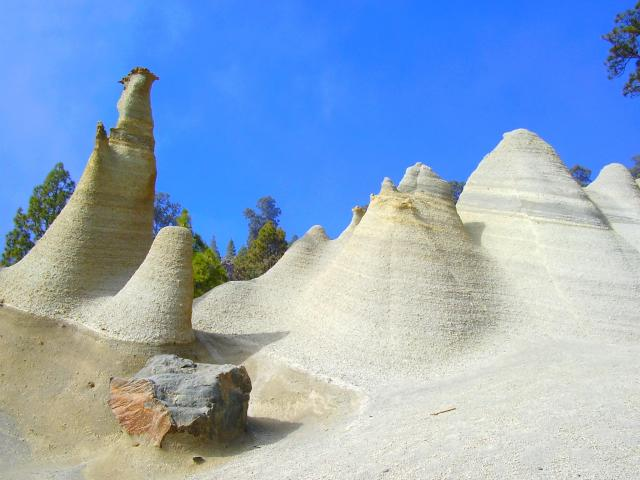
Within the Natural Park of the Forest Crown, to the south of the island of Tenerife, a path takes us to a lunar landscape, within the Chasna Road. Although the walk is done on foot with some difficulty, the landscape offers colorful rewards.
TOP 1:
Ucanca Valley, Teide National Park (Tenerife)
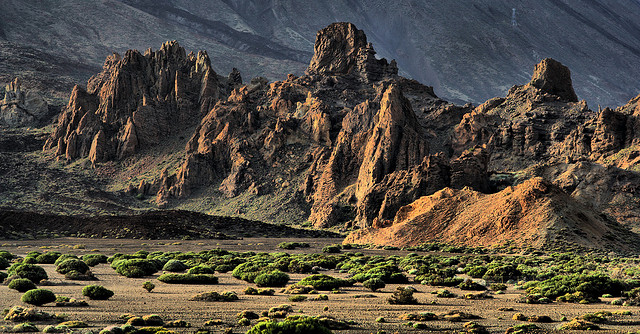
At the foot of the Teide, there is a valley that looks like perhaps we would think extraterrestrial (or Mars). This, due to its lifeless appearance, its reddish color, its formations and eroded rocks. It is called Valle de Ucanca, another surprise in the Teide National Park.

